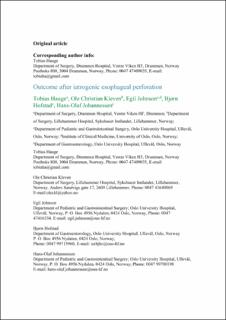| dc.contributor.author | Hauge, Tobias | |
| dc.contributor.author | Kleven, Ole Christian | |
| dc.contributor.author | Johnson, Egil | |
| dc.contributor.author | Hofstad, Bjørn | |
| dc.contributor.author | Johannessen, Hans Olaf | |
| dc.date.accessioned | 2020-04-07T14:03:01Z | |
| dc.date.available | 2020-04-07T14:03:01Z | |
| dc.date.created | 2019-06-20T10:06:51Z | |
| dc.date.issued | 2019 | |
| dc.identifier.citation | Scandinavian Journal of Gastroenterology. 2019, 54 (2), 140-144. | en_US |
| dc.identifier.issn | 0036-5521 | |
| dc.identifier.uri | https://hdl.handle.net/11250/2650693 | |
| dc.description.abstract | OBJECTIVES:
Iatrogenic perforations are the most common cause of esophageal perforation. We present our experience mainly based on a non-operative treatment approach as well as long-term outcome in these patients.
MATERIALS AND METHODS:
Twenty-one patients were treated for iatrogenic esophageal perforation at Oslo University Hospital, Ullevål from February 2007 to March 2014. The etiology of perforation was dilation of benign stricture in eight patients, either dilation, stenting or stent removal in four with malignant stenosis, during diagnostic endoscopy in four, removal of foreign body in two and by other causes in three patients, respectively. After median 82 months, 10 patients alive (47.6%) were sent questionnaires about dysphagia, HRQoL and fatigue.
RESULTS:
Median age at time of treatment was 66 years. Median in-hospital stay and mortality were 10.5 days and 4.8%, respectively. Initial treatment in 15 patients (71.4%) was non-surgical of whom one needed delayed debridement for pleural empyema. Initial treatment in six patients (28.6%) was surgical of whom three needed delayed stenting. Altogether 14 patients (66.7%) were stented. Eight (57.1%) had restenting. Median number of stents used was 1 (1-4). The stents were removed after median 36 days. The perforations healed after 2.5 months. After median 82 months, the patients reported reduced HRQoL. There was no significant difference regarding level of dysphagia and fatigue.
CONCLUSIONS:
We report satisfactorily short-term and long-term results of iatrogenic esophageal perforations. Mortality was low and HRQoL was deteriorated. Dysphagia and fatigue were comparable to a reference population. | en_US |
| dc.language.iso | eng | en_US |
| dc.rights | Attribution-NonCommercial-NoDerivatives 4.0 Internasjonal | * |
| dc.rights | Attribution-NonCommercial-NoDerivatives 4.0 Internasjonal | * |
| dc.rights.uri | http://creativecommons.org/licenses/by-nc-nd/4.0/deed.no | * |
| dc.subject | Latrogenic; | en_US |
| dc.subject | drainage; | en_US |
| dc.subject | dysphagia; | en_US |
| dc.subject | fatigue; | en_US |
| dc.subject | perforation; | en_US |
| dc.subject | quality of life; | en_US |
| dc.subject | resection; | en_US |
| dc.subject | stenting; | en_US |
| dc.subject | suture; | en_US |
| dc.title | Outcome after iatrogenic esophageal perforation | en_US |
| dc.type | Peer reviewed | en_US |
| dc.type | Journal article | en_US |
| dc.description.version | acceptedVersion | en_US |
| dc.rights.holder | Taylor and Francis | en_US |
| dc.source.pagenumber | 140-144 | en_US |
| dc.source.volume | 54 | en_US |
| dc.source.journal | Scandinavian Journal of Gastroenterology | en_US |
| dc.source.issue | 2 | en_US |
| dc.identifier.doi | 10.1080/00365521.2019.1575464 | |
| dc.identifier.cristin | 1706333 | |
| cristin.unitcode | 1991,6,8,0 | |
| cristin.unitname | Avd Kirurgi | |
| cristin.ispublished | true | |
| cristin.fulltext | preprint | |
| cristin.qualitycode | 1 | |

